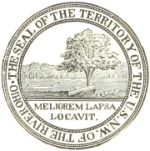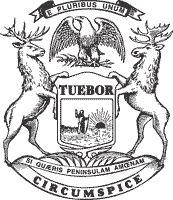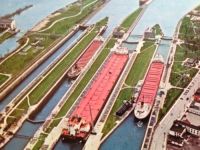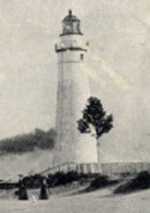
Michigan Archivist :
- Michigan Fast Facts -
By tradition Michigan is known as the "Wolverine State," however there has been only one confirmed wolverine sighting in the state in over two hundred years. It is also frequently called "Water-Winter Wonderland", "Great Lakes State", and the more popular "Mitten State" for obvious reasons.
The first European settlement was established in 1668 at Sault Ste. Marie by Jacques Marquette to serve as a base for Catholic Missions. In 1701 a small fort was erected between Lake St. Clair and Lake Erie, on the Detroit river, which today is the city of Detroit.
 On July 31, 1787 Michigan
became part of the Northwest Territory along with Illinois, Indiana, Wisconsin, Ohio, and the northeastern portion of Minnesota. Arthur St. Clair was appointed
as the first Territorial Governor. In 1796 Wayne county was established which included all the northwestern part of Ohio, a large portion of northeastern Indiana,
and the whole territory of Michigan. On July 4, 1800 the Northwest Territory was divided, the larger portion, including the Detroit area,
forming the new Indiana Territory. What remained was the eastern half of the lower peninsula, the easternmost tip of the upper peninsula and the area that
would later become Ohio. In 1802, when Ohio became a state, Michigan was again annexed to the Indiana Territory. On January 11, 1805, by a law to take
effect June 30, 1805, Congress divided Indiana Territory into two territories, named Indiana and Michigan. The latter was to include that part of Indiana
Territory lying north of a line drawn east from the southern end of Lake Michigan to Lake Erie. In April, 1816, Congress took a strip from the southern
part of the Territory, and included it in the bounds of the new State of Indiana.
On July 31, 1787 Michigan
became part of the Northwest Territory along with Illinois, Indiana, Wisconsin, Ohio, and the northeastern portion of Minnesota. Arthur St. Clair was appointed
as the first Territorial Governor. In 1796 Wayne county was established which included all the northwestern part of Ohio, a large portion of northeastern Indiana,
and the whole territory of Michigan. On July 4, 1800 the Northwest Territory was divided, the larger portion, including the Detroit area,
forming the new Indiana Territory. What remained was the eastern half of the lower peninsula, the easternmost tip of the upper peninsula and the area that
would later become Ohio. In 1802, when Ohio became a state, Michigan was again annexed to the Indiana Territory. On January 11, 1805, by a law to take
effect June 30, 1805, Congress divided Indiana Territory into two territories, named Indiana and Michigan. The latter was to include that part of Indiana
Territory lying north of a line drawn east from the southern end of Lake Michigan to Lake Erie. In April, 1816, Congress took a strip from the southern
part of the Territory, and included it in the bounds of the new State of Indiana.
 The opening of the Erie Canal in 1825 brought large numbers of settlers to Michigan seeking fresh opportunities in farming and lumbering.
Michigan was admitted to the Union as the 26th state on January 26, 1837, following a heated boundary dispute over the strip of land, known as the
"Toledo Strip," taken from Michigan's southern boundry in 1816.
The matter was resolved when Michigan relinquished its claim to the land in return for being granted statehood. Ohio gained the important shipping port
of Toledo and Michigan was granted the western portion of the Upper Peninsula; a compromise that was not met with enthusiasm by those in Michigan until
the realization of the vast wealth found in the natural resources of the area. Fisheries, furs, vast tracts of timber and seemingly inexhaustable
deposits of copper and iron ore have more than compensated for the loss of the 468-square-mile "Toledo Strip."
The opening of the Erie Canal in 1825 brought large numbers of settlers to Michigan seeking fresh opportunities in farming and lumbering.
Michigan was admitted to the Union as the 26th state on January 26, 1837, following a heated boundary dispute over the strip of land, known as the
"Toledo Strip," taken from Michigan's southern boundry in 1816.
The matter was resolved when Michigan relinquished its claim to the land in return for being granted statehood. Ohio gained the important shipping port
of Toledo and Michigan was granted the western portion of the Upper Peninsula; a compromise that was not met with enthusiasm by those in Michigan until
the realization of the vast wealth found in the natural resources of the area. Fisheries, furs, vast tracts of timber and seemingly inexhaustable
deposits of copper and iron ore have more than compensated for the loss of the 468-square-mile "Toledo Strip."
Now the problem arose of how to transport this immense wealth down from the Lake Superior country. The wooden plank road and tram method used to portage cargo around the rapids on the St. Mary's River, which drains Lake Superior into Lake Huron, was woefully inadequate. As early as 1837 Gov. Stevens T. Mason was pushing for the immediate construction of a canal as a necessity to navigation. Original construction costs were estimated at $112,000. For the next fifteen years Congress rejected, refused, denied and squelched all requests to appropriate funds necessary to build the canal. In 1852 a self-constituted committee (or lobby) spent most of the winter in Washington armed with samples of copper and iron ore while, at the same time, a media campaign was launched by the Lake Superior Journal to convince its readers that building the canal was a matter of national importance. Copies were sent to all members of Congress. Two bills were placed before Congress - one asking for $500,000 in funds and another asking for 500,000 acres of land. The request for funds was denied but 750,000 acres of land for the construction of the canal was approved. On April 19, 1855, water finally flowed through the completed canal. The steamer Illinois, in command of Capt. Jack Wilson, was the first vessel to pass through the new canal on June 18, 1855.
 It has been necessary to add additional, and larger locks as vessels grew in size and cargo increased. The Weitzel lock opened
on September 1, 1881; Poe lock, August 3, 1896; Davis lock, October 21, 1914; Sabin lock, September 18, 1919; McArthur lock took the place of the old
Weitzel lock and opened July 11, 1943; Poe lock redesigned and enlarged to 1,200 feet x 110 feet x 32 feet, opened June 26, 1969. Both the Davis and
Sabin locks are longer than the Poe but are only 80 feet wide and not able to handle the the goliaths of today with their 1000 foot keels and 105 foot
beams.
It has been necessary to add additional, and larger locks as vessels grew in size and cargo increased. The Weitzel lock opened
on September 1, 1881; Poe lock, August 3, 1896; Davis lock, October 21, 1914; Sabin lock, September 18, 1919; McArthur lock took the place of the old
Weitzel lock and opened July 11, 1943; Poe lock redesigned and enlarged to 1,200 feet x 110 feet x 32 feet, opened June 26, 1969. Both the Davis and
Sabin locks are longer than the Poe but are only 80 feet wide and not able to handle the the goliaths of today with their 1000 foot keels and 105 foot
beams.
Michigan is the only one of the fifty states to consist of two peninusulas. The upper and lower peninsula are separated by the the Straits of Mackinac, a five mile wide waterway connecting Lake Michigan and Lake Huron at the northernmost tip of the lower peninsula. From 1923 to 1957 travel between Mackinaw City and St. Ignace was made by car ferry. The Mackinac bridge was opened to traffic on November 1, 1957, ending the ferry service.
 Because Michigan
fronts on 4 of the 5 Great Lakes, as well as Lake St. Clair, it has the longest freshwater shoreline of any region in the world. The hundreds of miles of
shoreline also account for the fact that Michigan has more lighthouses than any other state. Historic and beautiful to look at, these lights remain
necessary aids to navigation; warning the long freighters away from dangerous reefs and shoals as they glide along between ports. The first of these beacons
to be built in Michigan is the Fort Gratiot light, built near the entrance of the
St. Clair river at Port Huron, in 1825. Owing to poor design and construction it collapsed
into the river during a severe storm in 1828. It was rebuilt in a better location the following year and today remains an active
navigational beacon and U.S. Coast Guard station.
Because Michigan
fronts on 4 of the 5 Great Lakes, as well as Lake St. Clair, it has the longest freshwater shoreline of any region in the world. The hundreds of miles of
shoreline also account for the fact that Michigan has more lighthouses than any other state. Historic and beautiful to look at, these lights remain
necessary aids to navigation; warning the long freighters away from dangerous reefs and shoals as they glide along between ports. The first of these beacons
to be built in Michigan is the Fort Gratiot light, built near the entrance of the
St. Clair river at Port Huron, in 1825. Owing to poor design and construction it collapsed
into the river during a severe storm in 1828. It was rebuilt in a better location the following year and today remains an active
navigational beacon and U.S. Coast Guard station.
Today Michigan has 83 counties which cover 96,176 square miles, making it the 11th largest state and 10th in population. Detroit is the largest city and was the state capital until 1847 when the capital was moved to Lansing.
The genealogical records held here are for use by the general public. These records have been submitted to the USGenNet Data Repository by volunteers and researchers just like you for permanent on-line free-access.





